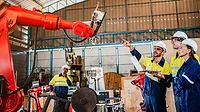It’s All about Value

It’s necessary to identify how and where technology can assist in providing better risk reduction results.
In this new millennium, our desire to tap into the overwhelming potential of a global economy plus our need for greater access and speed further compounds our need for better controls. And with that desire for more speed and market liquidity, we must remain vigilant to the ever-present complex security challenges we face.
The transportation and logistics market is valued at about $250 billion with an estimated $18 billion in losses. Companies are hiring global and regional security directors and moving towards centralized procurement and standardization of security requirements. This is good. But they also need to centralize security decision-making. They need to consider creating a more senior role within their organizations, such as a chief security officer who reports directly to the chief executive officer. This gives priority and adds visibility to security issues.
What Are Our Future Security Challenges?
Thieves have become more organized and sophisticated. Many gangs can “steal-to-order” digital cameras, athletic shoes or any other category of goods, depending on what “customers” want. Add to this trend the fact that there is always the looming threat of terrorism.Glenn Nilsson, Hewlett Packard’s global supply chain security manager and chairman of TAPA Americas, the Transported Asset Protection Association, said, “Theft cannot be measured solely by the value of goods, but also by the cost of lost market share, unhappy customers and making claims. It has been calculated that the overall loss is on average five times the value of goods stolen.”
The bottom line is that security must be built into the supply chain from the beginning. Specific incidents can have a major impact on transportation and logistics companies.
According to a 2006 PricewaterhouseCoopers study, when asked about the two most serious financial losses that affected their organizations, 20 percent of transportation and logistics companies worldwide indicated that crime was a key concern, compared with only nine percent of companies in other industries.
Decision-Making for Security Investments
The bottom line for investment into a new or replacement security system lies in clearly understanding the current security risk. This is as much about people and process change as it is about technology. To accomplish this, one might want to bring in outside consultants. In any event, a company needs to analyze the current situation in terms of meaningful metrics and resource utilization.To develop the desired security system and solutions, it is necessary to identify how and where technology can assist in providing better results. It is essential for vendors to serve as active listeners in a collaborative role and help customers to solve today’s security challenges while looking at ways to solve tomorrow’s challenges through thought leadership and innovation. Investments in emerging technologies may promise lower short-term margins, but might lead to true innovations and provide customers with a competitive advantage and longer-term market potential.
Value is ultimately determined by the customer. Vendors have to continue to find ways to add value in the marketplace. Either you add value or you become irrelevant.
Road Map for the Future
In the movie Minority Report, in the year 2054, actor Tom Cruise is a member of the Washington, D.C. pre-crime police force that can predict and intervene on crimes before they happen. I’d like to say we are developing solutions capable of predicting a crime before it occurs, but this is 2009 and we live in the real world – not Hollywood. However, we are optimistic about the convergence of IP-based smart security devices. With these devices security professionals can be more proactive in their fight against crime via data-driven, predictive security models. They can design loading patterns and processes using predictive security models to reduce the probability of risk or determine what levels of vulnerability are acceptable so goods are not left exposed. We’re looking at a layered approach that includes redundancy, where if one deterrent fails another will kick in to catch, alert or lock-down. We’re looking into tighter integration of security software solutions that can make some predetermined decisions without human intervention.What’s changing is the intelligence in our devices and the ways we can integrate them or provide more analytical capabilities that can provide pattern recognition of freight movements.
We need to increase the priority of security within the corporate boardrooms and tie these initiatives into the overall IT strategies. Chief information officers need to be included in the security conversation as our devices become smarter and we leverage existing IT infrastructure and projects.
In today’s world, transportation security is a major concern. There is strong pressure from Washington to provide more security to prevent terrorists from disrupting our global transportation network and companies looking to reduce their cost of inventory shrinkage. Our mission is to clearly define the problems, understand our customer’s issues and develop innovative security solutions that will meet the challenges ahead.
Looking for a reprint of this article?
From high-res PDFs to custom plaques, order your copy today!







